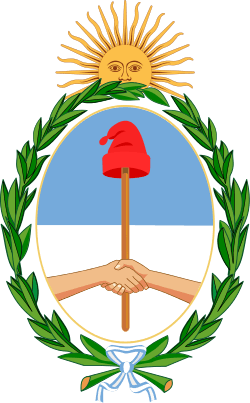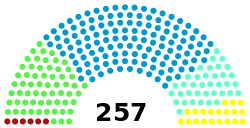Argentine Chamber of Deputies
| Argentine Chamber of Deputies Honorable Cámara de Diputados de la Nación | |
|---|---|
 | |
| Type | |
| Type |
Lower House |
| Leadership | |
1st Vice President of the Chamber | |
Majority Leader | |
Minority Leader | |
| Structure | |
| Seats | 257 (List) |
 | |
Political groups | |
| Elections | |
|
Party-list proportional representation D'Hondt method | |
Last election | 27 October 2013 |
| Meeting place | |
 | |
|
Chamber of Deputies, Argentine Congress, Buenos Aires, Argentina | |
| Website | |
| http://www.diputados.gov.ar | |
The Chamber of Deputies is the lower house of the Argentine National Congress. This Chamber holds exclusive rights to levy taxes; to draft troops; and to accuse the President, cabinet ministers, and members of the Supreme Court before the Senate.
Composition
It has 257 seats and one-half of the members are elected every two years to serve four-year terms by the people of each district (23 Provinces and the Autonomous City of Buenos Aires) using proportional representation, D'Hondt formula with a 3% of the district registered voters threshold, and the following distribution:
| Province | Total deputies |
|---|---|
| Buenos Aires Autonomous City | 25 |
| Buenos Aires Province | 70 |
| Catamarca Province | 5 |
| Chaco Province | 7 |
| Chubut Province | 5 |
| Córdoba Province | 18 |
| Corrientes Province | 7 |
| Entre Ríos Province | 9 |
| Formosa Province | 5 |
| Jujuy Province | 6 |
| La Pampa Province | 5 |
| La Rioja Province | 5 |
| Mendoza Province | 10 |
| Misiones Province | 7 |
| Neuquén Province | 5 |
| Río Negro Province | 5 |
| Salta Province | 7 |
| San Juan Province | 6 |
| San Luis Province | 5 |
| Santa Cruz Province | 5 |
| Santa Fe Province | 19 |
| Santiago del Estero Province | 7 |
| Tucumán Province | 9 |
| Tierra del Fuego Province | 5 |
| Total | 257 |
Requirements
In order for an Argentine citizen to be elected to congress, it has to fulfil certain requirements: He or she has to be at least twenty five years old with at least four years of active citizenship and it has to be naturalized in the province that is being elected to or at least have two years of immediate residency in said province, according to art. 48 or the Argentine Constitution.
History
The Chamber of Deputies was provided for in the Constitution of Argentina, ratified on May 1, 1853. Eligibility requisites are that members be at least twenty-five years old, and have been a resident of the province they represent for at least four years; as congressional seats are elected at-large, members nominally represent their province, rather than a district.[1]
Otherwise patterned after Article One of the United States Constitution per legal scholar Juan Bautista Alberdi's treatise, Bases de la Constitución Argentina, the chamber was originally apportioned in one seat per 33,000 inhabitants. The constitution made no provision for a national census, however, and because the Argentine population doubled every twenty years from 1870 to 1930 as a result of immigration (disproportionately benefiting Buenos Aires and the Pampas area provinces), censuses were conducted generationally, rather than every decade, until 1947.[2]
Apportionment controversy
The distribution of the Chamber of Deputies is regulated since 1983 by Law 22.847, also called Ley Bignone, enacted by the last Argentine dictator, General Reynaldo Bignone, ahead of the 1983 general elections. This law established that, initially, each province shall have one deputy per 161,000 inhabitants, with standard rounding; after this is calculated, each province is granted three more deputies. If a province has fewer than five deputies, the number of deputies for that province is increased to reach that minimum.
Controversially, apportionment remains based on the 1980 population census, and has not been modified since 1983; national censuses since then have been conducted in 1991, 2001, and 2010. The minimum of five seat per province allots the smaller ones a disproportionately large representation, as well. Accordingly, this distribution does not reflect Argentina's current population balance.
Presidents of the Chamber
The President of the Chamber is elected by the majority caucus. The officeholders for this post since 1983 have been:
| Term began | Term ended | Officeholder | Party | Province |
|---|---|---|---|---|
| December 10, 1983 | April 3, 1989 | Juan Carlos Pugliese | UCR | |
| April 3, 1989 | July 8, 1989 | Leopoldo Moreau | UCR | |
| July 8, 1989 | December 10, 1999 | Alberto Pierri | PJ | |
| December 10, 1999 | December 10, 2001 | Rafael Pascual | UCR | |
| December 10, 2001 | December 10, 2005 | Eduardo Camaño | PJ | |
| December 10, 2005 | December 10, 2007 | Alberto Balestrini | FPV - PJ | |
| December 10, 2007 | December 6, 2011 | Eduardo Fellner | FPV - PJ | |
| December 6, 2011 | to date | Julián Domínguez | FPV - PJ |
Current authorities
Leadership positions include:
| Title | Officeholder | Party | Province |
|---|---|---|---|
| Chamber President | Julián Domínguez | FPV | |
| First Vice-President | Norma Abdala de Matarazzo | Civic Front for Santiago | |
| Second Vice-President | Mario Negri | UCR | |
| Third Vice-President | Alicia Ciciliani | Socialist | |
| Parliamentary Secretary | Gervasio Bozzano | ||
| Administrative Secretary | José Gaincerain | ||
| Coordinating Secretary | Ricardo Patterson |
Composition by Party blocks
| Political Party | Seats | Net Change in seats |
% of Votes |
Caucus leader |
|---|---|---|---|---|
| Front for Victory | 115 | 50.8 | Juliana Di Tullio | |
| Radical Civic Union | 38 | 13.5 | Ricardo Gil Lavedra | |
| Federal Peronism | 23 | 10.5 | Enrique Thomas | |
| Republican Proposal | 11 | = | 2.2 | Federico Pinedo |
| Civic Front for Santiago (allied with Front for Victory) | 7 | = | 1.4 | Daniel Brue |
| Civic Coalition | 6 | 3.0 | Alfonso Prat Gay | |
| Socialist Party (Progressive Ample Front) | 6 | = | 13.6* | Juan Zabalza |
| New Encounter (allied with Front for Victory) | 5 | = | n.a. | Martín Sabbatella |
| Generation for a National Encounter (Progressive Ample Front) | 5 | = | * | Margarita Stolbizer |
| Córdoba Civic Front (allied with Civic Coalition) | 5 | 0.2 | Ernesto Martínez | |
| Popular Unity (Progressive Ample Front) | 5 | * | Claudio Lozano | |
| Neuquén People's Movement | 3 | = | 0.3 | Alicia Comelli |
| Project South | 3 | 0.2 | Fernando Solanas | |
| Peronist Union | 3 | n.a. | Felipe Solá | |
| Others (18 parties) | 22 | 4.3 | ||
| Total | 257 | [3][4] |
* Total includes all parties in FAP, led by the Socialist Party.
2009 election
See List of current Argentine Deputies and Argentine legislative election, 2009
| Political Party |
Seats |
Net Change in seats |
% of Votes |
Caucus leader |
|---|---|---|---|---|
| Front for Victory | 87 | -20 | 26.7 | Agustín Rossi |
| Radical Civic Union | 43 | +14 | 9.0 | Oscar Aguad |
| Federal Peronism | 29 | +25 | 8.7 | Felipe Solá |
| Civic Coalition | 19 | +4 | 18.1 | Elisa Carrió |
| Republican Proposal | 11 | +3 | 18.5 | Federico Pinedo |
| Civic Front for Santiago (allied with Front for Victory) | 7 | +1 | 1.0 | Daniel Brue |
| Socialist Party | 6 | -4 | 0.8 | Mónica Fein |
| Peronist Party | 6 | -2 | 0.7 | ~ |
| New Popular and Solidary Encounter | 5 | +5 | 2.1 | Martín Sabbatella |
| Generation for a National Encounter | 5 | +3 | 2.0 | Margarita Stolbizer |
| Project South | 4 | +3 | 2.3 | Fernando Solanas |
| Córdoba Civic Front (allied with Civic Coalition) | 3 | +3 | 2.4 | Ernesto Martínez |
| Neuquén People's Movement | 3 | 0 | 0.4 | Alicia Comelli |
| Solidarity and Equality | 3 | -4 | 0.5 | Eduardo Macaluse |
| Others (21 parties) | 26 | -31 | 6.8 | |
| Total | 254 |
2007 election
See Argentine general election, 2007
References
- ↑ Honorable Senado de la Nación: Constitución Nacional (Spanish)
- ↑ Indec: Historia de los censos (Spanish)
- ↑ "Presidentes de Bloques". HCDN.
- ↑ "Diputados Nacionales (2011)". Atlas Electoral de Andy Tow.
External links
| Wikimedia Commons has media related to Parliaments of Argentina. |
| ||||||||||||||||||||||